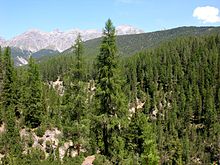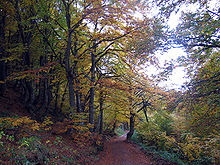Forest
| This article needs additional citations for verification. (August 2011) |
A forest, also referred to as a wood or the woods, is an area with a high density of trees. As with cities, depending on various cultural definitions, what is considered a forest may vary significantly in size and have different classifications according to how and of what the forest is composed.[1] A forest is usually an area filled with trees but any tall densely packed area of vegetation may be considered a forest, even underwater vegetation such as kelp forests, or non-vegetation such as fungi,[2] and bacteria. Tree forests cover approximately 9.4 percent of the Earth's surface (or 30 percent of total land area), though they once covered much more (about 50 percent of total land area). They function as habitats for organisms, hydrologic flow modulators, and soil conservers, constituting one of the most important aspects of the biosphere.
A typical tree forest is composed of the overstory (canopy or upper tree layer) and the understory. The understory is further subdivided into the shrub layer, herb layer, and also the moss layer and soil microbes. In some complex forests, there is also a well-defined lower tree layer. Forests are central to all human life because they provide a diverse range of resources: they store carbon, aid in regulating the planetary climate, purify water and mitigate natural hazards such as floods. Forests also contain roughly 90 percent of the world's terrestrial biodiversity.[3]
Contents
[hide]Etymology[edit]

The word "forest" comes from Middle English forest, from Old French forest (also forès) "forest, vast expanse covered by trees"; first introduced in English as the word for wild land set aside for hunting[5] without the necessity in definition for the existence of trees (James 1981;Muir 2000,2008).[6] Possibly a borrowing (probably via Frankish or Old High German) of the Medieval Latin word foresta "open wood", foresta was first used by Carolingian scribes in the Capitularies of Charlemagne to refer specifically to the king's royal hunting grounds. The term was not endemic to Romance languages (e.g. native words for "forest" in the Romance languages evolved out of the Latin word silva "forest, wood" (English sylvan); cf. Italian, Spanish, Portuguese selva; Romanian silvă; Old French selve); and cognates in Romance languages, such as Italian foresta, Spanish and Portuguese floresta, etc. are all ultimately borrowings of the French word.
The exact origin of Medieval Latin foresta is obscure. Some authorities claim the word derives from the Late Latin phrase forestam silvam, meaning "the outer wood"; others claim the term is a latinisation of the Frankish word *forhist "forest, wooded country", assimilated to forestam silvam (a common practice among Frankish scribes). Frankish *forhist is attested by Old High German forst "forest", Middle Low German vorst "forest", Old English fyrhþ "forest, woodland, game preserve, hunting ground" (English frith), and Old Norse fýri "coniferous forest", all of which derive from Proto-Germanic *furhísa-, *furhíþija- "a fir-wood, coniferous forest", from Proto-Indo-European *perkwu- "a coniferous or mountain forest, wooded height".
Uses of the word "forest" in English to denote any uninhabited area of non-enclosure are now considered archaic.[7] The word was introduced by the Norman rulers of England as a legal term (appearing in Latin texts like the Magna Carta) denoting an uncultivated area legally set aside for hunting by feudal nobility (see Royal Forest).[7][8] These hunting forests were not necessarily wooded much, if at all. However, as hunting forests did often include considerable areas of woodland, the word "forest" eventually came to mean wooded land more generally.[

